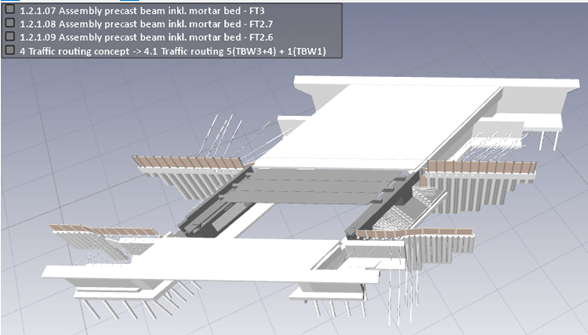Author: M.Sc. Pia Beilenhoff
Tutor: Eng. Giovanni Franchi
Master: Master in “Project management in construction works with BIM”
Student Year: 2022/2023
Productivity and digitization in the construction industry have stagnated for a long time. In the past, delays and budget overruns have repeatedly occurred, particularly in the planning and con-struction of large-scale projects. The large volume of data that is generated during the life cycle of a building was not collected and stored efficiently. Therefore, it is a great need for structured and value-adding data management as well as digital methods for the cross-process view of a con-struction project.
A solution to the increasing complexity of the construction industry is the use of digital opportuni-ties to increase the productivity with the working and planning method Building Information Model-ing (BIM), which is attracting more and more attention in the architecture, engineering and con-struction (AEC) industry. BIM offers considerable digitization potential and aims to increase effi-ciency, communication, quality, cost and schedule reliability as well as sustainability.
The thesis includes the investigation of the implementation and application of BIM on a 6-lane bridge replacement project that is currently being carried out as a BIM pilot project, tendered by a public client. Therefor a clear understanding of BIM and its informative dimensions, the strategic targets, as well as the necessary legal, organizational, technical and process-based requirements for the effective integration of BIM are explained.
The existing bridge is an approximately 31-metre-long and 42-metre-wide, single-span concrete bridge, consisting of four partial structures, of which two inner sections were built in 1956 and widened on both sides in 1980. In particular, the inner partial structures are no longer able to cope with the high traffic load. The new bridge structure (see Fig. 1) will be rebuilt in the same position as the existing structure. The challenge of this construction project is to maintain traffic on the highway with as little disruption as possible during the construction of the new bridge. For this reason, the bridge is being reconstructed in several sections (see Fig. 2) in a confined space and with complex construction site logistics. Another challenge is the short construction period that was planned for the replacement of the bridge.
Based on the pilot project, the current role of BIM and the practical applications of BIM use cases in the planning, executive and operational phase are examined, and further useful potential appli-cations presented. Challenges, the impact and changes through BIM as well as potentials and limitations in the pilot project are analyzed. Inefficiencies resulting from faulty processes are iden-tified and possible measures and methods as well as project management tools for the planning and construction process optimization are developed.
The aim of the thesis is to work out how project management can be supported by BIM to ensure the success of the project in terms of on-time completion, budget compliance and quality assur-ance. This is accompanied by further project objectives, such as risk management to identify and control risks that could affect the course of the project and successful communication and coordi-nation between all parties involved.
The combination of BIM with the Integrated Project Delivery (IPD) method, based on agile project management and lean management and construction principles, is identified as an effective method, to improve the management through increased data exchange and to increase efficiency through better involvement and coordination of all parties involved.
Besides that, the integrated project management software Bexel Manager, which is geared to-wards the use of BIM and the efficient management of construction projects is identified as a pos-sible tool for optimizing the success of the pilot project. The aim of the practical application of Bexel Manager in the thesis is to show how construction projects can be managed more efficiently and transparently by using such software with a holistic view of the project through the compre-hensive integration of various functions and data sources.
After reworking the information models of the pilot project (models of the existing bridge, new bridge, pit shoring, drainage pipes, etc.) in Revit and connecting the model elements with a previ-ously project-specific developed Work Breakdown Structure, the models are exemplary used for several functions in the software Bexel. Therefor Selection Sets and Custom Breakdown Struc-tures are created. Tools like 3D model coordination, property checking, 4D project scheduling and construction process animation via the zone editor (see Fig. 4), 5D cost data base with assign-ment of cost items to model elements, are presented.
Examples for program-intern created Quantity Take Offs (see Fig. 3) show, how quantities can easily be determined and used for cost estimates for the offer, billing of construction services or ordering materials. Especially the 4D model is useful in the pilot project for visual control and op-timization of the construction sequence through the schedule animation, by linking the model ele-ments with the schedule (see Fig. 5). It helps to visualize the construction process and enables progress controls of the construction site. On the project management side, 4D BIM is useful for facilitating the planning and management of the construction schedule. By viewing the construc-tion schedule in the context of the model, project managers can identify scheduling issues and overlaps.
The investigations in the pilot project conclude that with careful and consistent implementation of the project-specific BIM use cases, changes within appropriate technologies and employees on the part of both, the authorities and the executing companies, BIM can fulfill its purpose and can serve benefits in terms of improved design quality, improved communication and data exchange, the reduction of design errors and consequently construction costs, support for construction and project management and likely greater operational efficiency in the lifecycle of the building for the owners.
Figure 1: Extract Floor plan variant 1
Figure 2: Extract Construction phase 1.2 (New BA1.1) and Phase 2.1 (Demolition BA1.2)
Figure 3: Extract Bexel Manager, QTO Soldier piles
Figure 4: Extract Bexel Manager, Zone editor for the creation of the Gantt chart





